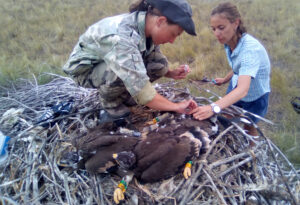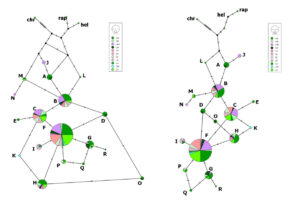Third International Scientific and Practical Conference “Eagles of the Palearctic: Study and Conservation”
Raptors Conservation. Suppl. 2. Proceedings of Conferences
Steppe eagle population structure genetic study: is there hope for the endangered species?
Zinevich L.S. (All-Russian Research Institute for Environmental Protection, Moscow, Russia)
Schepetov D.M., Tambovtseva V.G. (Koltzov Institute of Developmental Biology Russian Academy of Sciences, Moscow, Russia)
Bekmansurov R.H. (Kazan Federal University, Elabuga Institute, National Park “Nizhnyaya Kama”, Elabuga, Russia)
Pulikova G.I. (Biodiversity Research and Conservation Center Community Trust, Astana, Kazakhstan)
Nikolenko E.G., Karyakin I.V. (Russian Raptor Research and Conservation Network; Sibecocenter LLC, Novosibirsk, Russia)
Contact:
Lyudmila Zinevich lzinevich@gmail.com
Dmitry Schepetov denlior@gmail.com
Valentina Tambovceva lynx1994@gmail.com
Rinur Bekmansurov rinur@yandex.ru
Genriyetta Pulikova genriyetta.pulikova@gmail.com
Elvira Nikolenko elviranikolenko@gmail.com
Igor Karyakin ikar_research@mail.ru
Recommended citation: Zinevich L.S., Schepetov D.M., Tambovtseva V.G., Bekmansurov R.H., Pulikova G.I., Nikolenko E.G., Karyakin I.V. Steppe Eagle Population Structure Genetic Study: is There Hope for the Endangered Species? – Raptors Conservation. 2023. S2: 342–346. DOI: 10.19074/1814-8654-2023-2-342-346 URL: http://rrrcn.ru/en/archives/35132
Steppe Eagle (Aquila nipalensis) had been the most numerous Palearctic Aquila species, but nowadays it has been decreasing in numbers progressively, so in 2015 the IUCN changed the species status to “endangered”. The decrease is evidently related to Steppe Eagles’ electrocution at nesting areas and during migration, poisoning by veterinarian drugs feeding on agricultural animal carcasses at wintering grounds, steppe fires and total habitat loss combined with loss of prey like susliks. To the contrary, the sister Aquila species, the Imperial Eagle (Aquila heliaca) which exhibits similar biological traits and lives simpatrically to the Steppe Eagle at some parts of areas, shows local increase in numbers and even substitutes the decreasing Steppe Eagle in steppe biomes. In 1960s, many Palearctic birds of prey came through population decline due to so-called «DDT crisis» – massive pesticide poisoning. To restore the species numbers, specific conservation actions were initiated in Europe to support population numbers and genetic diversity of raptors. Regarding the Steppe Eagle with its nesting area located mostly at Qazaqstan, Russian, Mongolian and Chinese territories, the implications of DDT and electrocution impacts on the population numbers stayed poorly investigated.
Meanwhile, loss of genetic stability can be a reason for lasting population decline. Genetic threats like population fragmentation, genetic erosion and inbreeding depression are believed more prolonged in comparison to anthropogenic impacts and more rarely come under increasing scrutiny of conservation practitioners. However, if exist, they can lead to species extinction regardless of removal of all other threats.
The Steppe Eagle population structure stays poorly investigated. In 2018, during the 1st Steppe Eagle conservation international workshop this problem was highlighted with recommendations for filling this gap. Our presented study was conducted following this recommendation and focused on genetic structure, fragmentation and effective number comparison of the Steppe Eagle population at the major part of its nesting areas (about 250 individual samples) and sympatric populations of the Imperial Eagle (over 100 samples). For conservation criteria estimation, we used widespread genetic markers like nuclear microsatellites (9 loci) and mitochondrial control region (D-loop). Also we performed molecular individual tagging and parentage analysis to study the population structure using samples from the numerous Western Kazakhstan population. We also used GIS methods to study geographic fragmentation of populations.
The genetic analysis showed that the Steppe Eagle population structure is highly similar to that of the Imperial Eagle but with less genetic diversity and have some traces of multiple coming through bottleneck with huge population number and genetic diversity decline. Fragmentation analysis showed no genetic isolation of geographically fragmented nesting groups despite of presumed natal phylopatry in accordance with our Steppe Eagle parentage data. Preliminary estimation of the Steppe Eagle population effective numbers by linkage disequilibrium method showed rather high values inspite of the lasting population decline. The molecular coancestry estimation showed more serious decline during the latest bottleneck which was also far below the ancestral Imperial Eagle population at the studied areas. The inbreeding rate for the Steppe Eagle population at the most part of the species areas turned out to outnumber one for the local population of the Imperial Eagle.
Our data showed no immediate genetic threats for the Steppe Eagle population restoration and also demonstrated traces of multiple bottlenecks in the species evolution. Still the genetic structure of the species population keeps some traits of modern decline and should be monitored permanently according to the species numbers. Unique population structure patterns of the Steppe Eagle between other Aquila species and their conservation aspects are directions for future Aquila nipalensis genetic research.

Lyudmila Zinevich and Genriyetta Pulikova collect feather pulp from steppe eagle (Aquila nipalensis) chicks for molecular genetic studies. Photo by I. Karyakin.

The Steppe Eagle D-loop polymorphic region haplotypes networks. Methods: A – TCS (Clement et al., 2002); B – Median Joining epsilon=0 (Bandelt et al., 1999).
